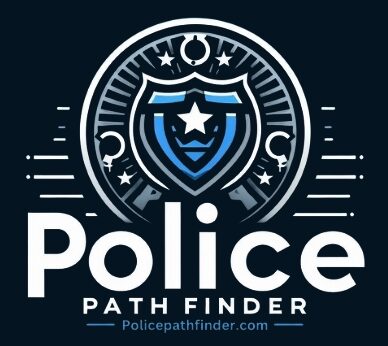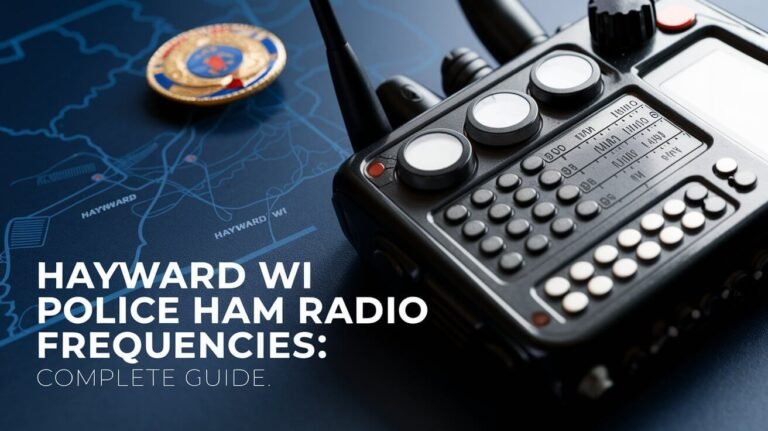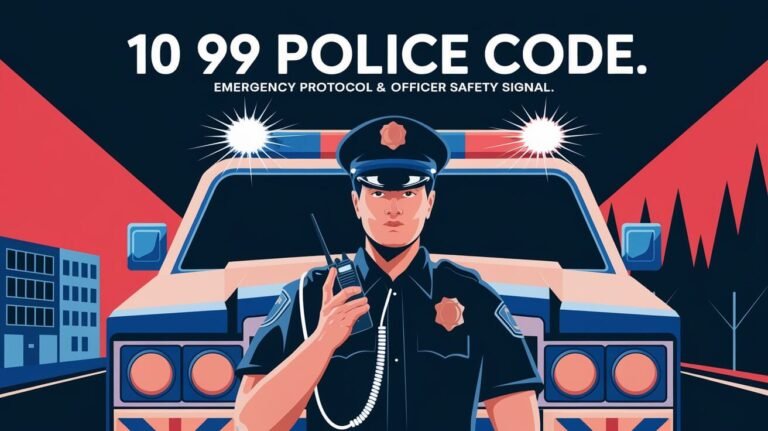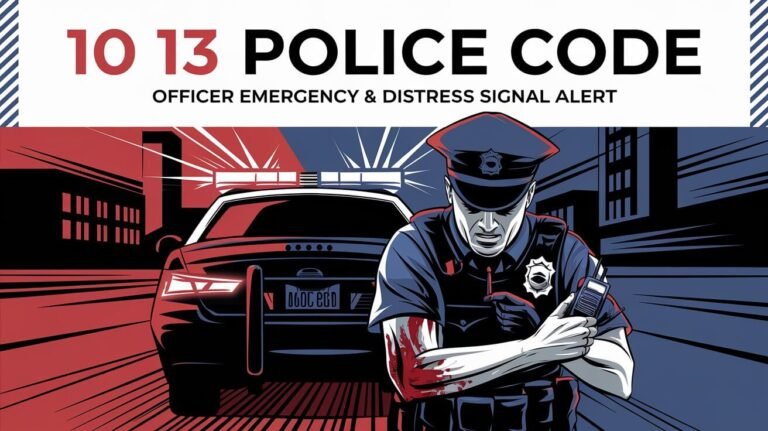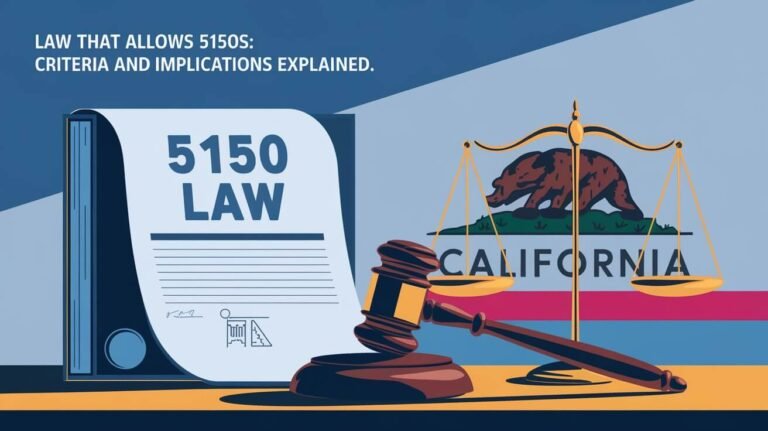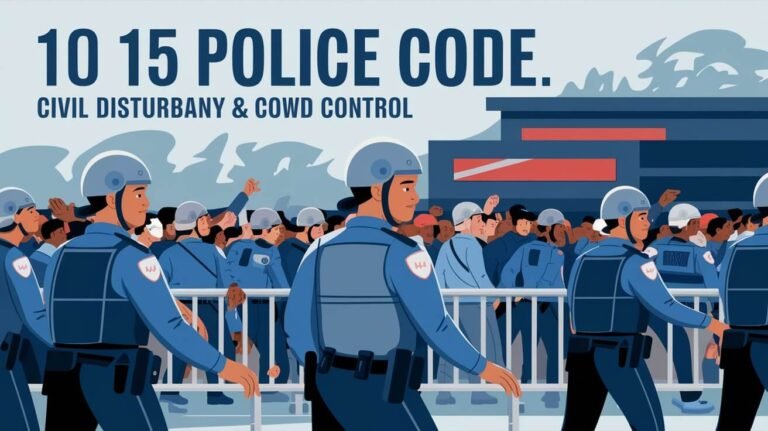10-50 Police Code: Vehicle Accident Protocol & Response Details
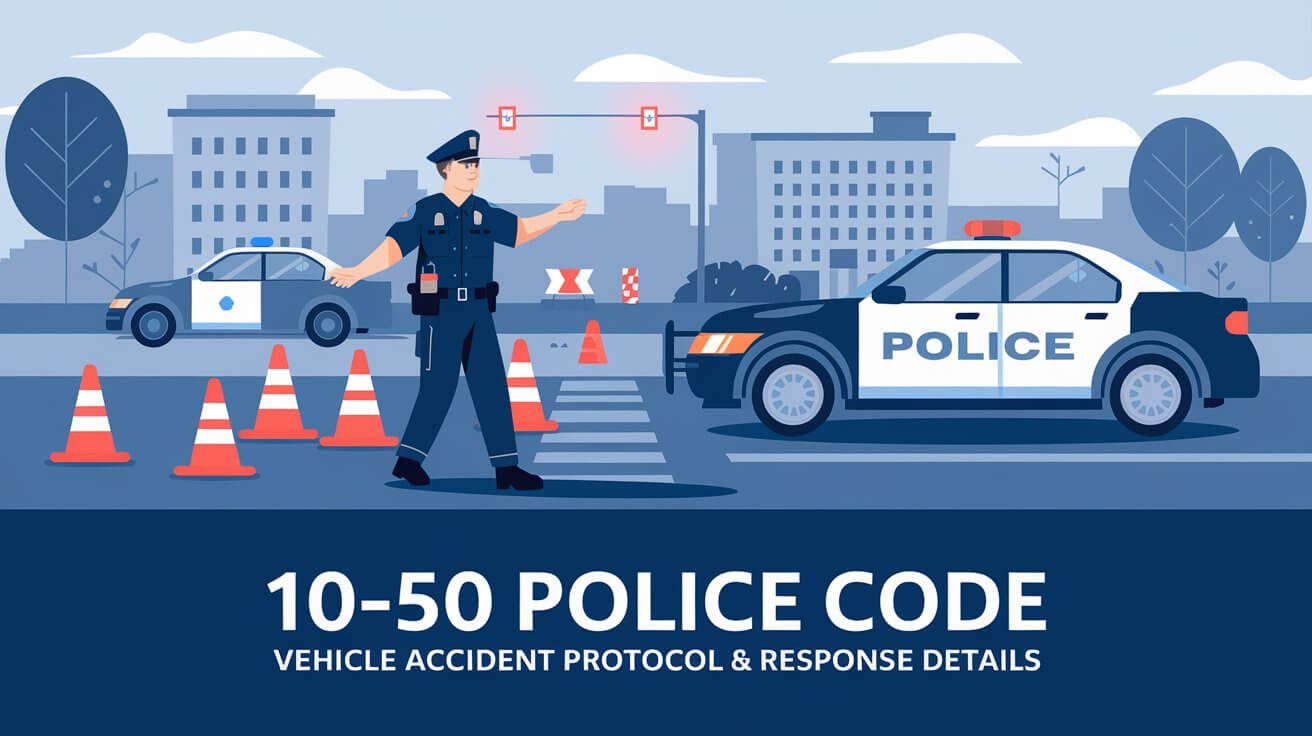
In law enforcement, the 10-50 police code is key for emergency communication. It’s used by officers across the U.S. to signal a traffic accident. The code can detail the accident, like 10-50F for fire, 10-50PI for personal injury, or 10-50PD for property damage.
The 10-50 code shows how vital radio communication is in law enforcement. It helps officers share vital info fast. This ensures a quick and effective response to emergencies. Knowing the 10-50 code well is a must for law enforcement training and daily work.
Radio Communication Basics in Law Enforcement
Effective police dispatching uses standardized radio protocols and codes. Law enforcement often uses the iconic ten-codes. These codes were developed decades ago to improve efficiency and clarity on the radio.
These ten-codes, along with the phonetic alphabet and clear speech, are key. They form the foundation of radio protocol in law enforcement.
Radio Protocol Fundamentals
The ten-codes, or “ten signals,” were first introduced in the 1930s. Charles “Charlie” Hopper, the communications director for the Illinois State Police, came up with the idea. They help officers quickly share information and avoid confusion in noisy places.
These codes create a shared language among law enforcement officers. They make communication faster and clearer.
Standard Operating Procedures
Law enforcement agencies have detailed SOPs for radio communication. These SOPs cover radio etiquette, priority levels, and incident coding. They ensure information is exchanged efficiently and securely during police dispatching.
Officers are trained to follow these protocols. This helps keep them safe and ensures accurate incident coding.
Communication Equipment Overview
- Handheld radios: Portable devices carried by individual officers for on-the-go communication.
- Vehicle-mounted radios: Radios installed in police vehicles, providing reliable communication while on patrol.
- Dispatch consoles: Centralized communication hubs managed by dispatchers, coordinating emergency response and officer deployment.
These radio communication basics, SOPs, and equipment are essential. They help make police dispatching efficient and effective. They promote officer safety and accurate incident coding in law enforcement operations.
10-50 Police Code: Traffic Accident Categories
The 10-50 police code is key in talking about traffic incidents. It groups different types of accidents, helping first responders know what to do fast. This system makes it easier for officers to share important details quickly, speeding up help.
There are three main types of accidents in the 10-50 code:
- 10-50 PD (Property Damage): Only property is damaged, no people hurt.
- 10-50 PI (Personal Injury): People are injured and need medical help.
- 10-50 F (Fire/Fatality): There’s a fire, explosion, or someone has died.
These categories help first responders send the right help fast. They can quickly figure out what happened and how bad it is. This means they can act quickly to help, keep the area safe, and get traffic moving again.
| Accident Type | Description | Required Response |
|---|---|---|
| 10-50 PD | Property Damage Accidents | Secure the scene, document the incident, and facilitate the exchange of insurance information between parties. |
| 10-50 PI | Personal Injury Accidents | Provide immediate medical attention, secure the scene, and notify emergency medical services for transport to a hospital. |
| 10-50 F | Fire/Fatality Accidents | Initiate fire suppression efforts, secure the scene, request additional resources (fire department, coroner, etc.), and establish a perimeter to manage the incident. |
Knowing the 10-50 police code helps first responders work better in emergencies. It keeps everyone safe and reduces the effect of accidents on the area.
Emergency Response Protocols in Accident Scenarios
First responders must act fast in traffic accidents. They quickly check the scene, send the right help, and make a safe area. These steps help them respond quickly and safely, protecting everyone.
Initial Scene Assessment
First responders check the accident scene fast. They see how bad it is, count the cars, look for injuries, and find dangers like spills. This helps them know what to do first.
Resource Deployment Guidelines
After checking the scene, responders use rules to send the right help. For small accidents, they might just need one engine and a medic. But bigger accidents need more, like extra engines and a medic unit.
Very serious accidents, like ones with pedestrians or rollovers, need even more. This includes more engines, a battalion, and maybe air transport.
Safety Perimeter Establishment
First responders make a safe area around the accident. They block off the area, move traffic, and put up signs. This keeps the scene safe, letting responders focus on helping victims and managing the scene.
Good crisis management and first responder actions are key in accidents. By following these steps, responders can quickly assess, send help, and keep the scene safe. This makes the response better and helps everyone involved.
Common Police Radio Codes for Traffic Incidents
Police radio codes are key in law enforcement communication. They help manage traffic efficiently. The 10-50 code for a traffic accident is well-known. But, there are many other codes for different traffic incidents.
Some common police radio codes for traffic incidents include:
- 10-51: Wrecker needed
- 10-52: Ambulance needed
- 10-53: Road blocked
- 10-54: Hit and run
- 10-55: Intoxicated driver
These codes help officers quickly share the details of a traffic incident. This makes traffic management smoother. It also helps officers respond fast to emergencies.
| Code | Meaning |
|---|---|
| 10-51 | Wrecker needed |
| 10-52 | Ambulance needed |
| 10-53 | Road blocked |
| 10-54 | Hit and run |
| 10-55 | Intoxicated driver |
Using these police radio codes helps officers share important info. It helps them coordinate emergency responses. And it keeps the public safe during traffic incidents.
Accident Classification and Response Levels
When it comes to traffic incidents, knowing the accident’s severity is key. Police use the “10-50” code to report accidents. They categorize them into three main groups: property damage, personal injury, and fatal accidents. Each group needs its own set of protocols and resources for effective management.
Property Damage Accidents
Property damage accidents, or “10-50PD,” happen when there’s no injury and only property is damaged. These incidents need a lower emergency response. Officers secure the scene, collect information, and help with insurance details.
Personal Injury Collisions
Personal injury collisions, or “10-50PI,” are more serious. They involve injuries, from minor to severe. A higher emergency response is needed, with more resources like ambulances and fire trucks. Officers focus on medical needs while managing the scene and evidence.
Fatal Accident Protocols
Fatal accidents, or “10-79,” are the most severe. They need the highest emergency response and special protocols. Officers secure the scene, provide medical care, and notify the coroner. They also start a detailed investigation to find the cause and any criminal charges. The response is complex and thorough.
Effective traffic incident management depends on accurate accident classification. Law enforcement must use the “10-50” code and its subcategories. This way, they can respond quickly and efficiently. It helps keep traffic flowing and ensures safety for everyone involved.
Dispatch Communication Standards
In police dispatching, clear and efficient communication is essential. Emergency responders use standardized protocols and codes to share vital information quickly and accurately. The 10-50 Police Code, for example, covers incidents from property damage to fire emergencies.
Dispatchers are vital in coordinating emergency responses. They use codes like “10-9” for message repeats and “10-13” for weather updates. These procedures help police, fire, and medical teams respond fast and effectively, reducing the impact of emergencies.
| Code | Meaning |
|---|---|
| 10-10 | Fight in progress |
| 10-31 | Crime in progress |
| 10-50 | Accident (fatal, personal injury, property damage) |
| 10-70 | Fire |
| 10-75 | In contact with… |
| 10-80 | Chase in progress |
| 10-88 | Present telephone number of… |
| 10-91 | Pick up prisoner/subject |
| 10-96 | Mental subject |
| 10-99 | Wanted/stolen indicated |
These standards ensure police dispatching, emergency communication, and radio protocols are followed. This leads to a coordinated and effective emergency response. By using these protocols, law enforcement and first responders can handle various incidents efficiently and safely.
First Responder Coordination Methods
Effective emergency coordination is key for smooth incident management. It involves a clear command structure and common communication protocols. The Incident Command System (ICS) is often used for this.
Multi-Agency Response Protocols
First responders from different agencies must work together at complex accident scenes. They include law enforcement, fire departments, and emergency medical services. Multi-agency protocols help them work together under one command and follow the same procedures.
Scene Command Structure
A clear command structure is essential for managing an accident scene. The Incident Command System (ICS) helps set this up. It designates a lead agency and incident commander to oversee the response.
This system ensures efficient use of resources, communication, and decision-making. It helps first responders work together well in emergencies.
Documentation Requirements for 10-50 Incidents
Handling 10-50 incidents, or traffic accidents, requires careful documentation. Police officers must record all important details. This ensures accurate records and helps with accident reporting.
They gather key information like the accident’s location, time, and the vehicles involved. They also take statements from drivers and witnesses, and take photos.
Officers use specific police codes to make documentation easier. For example, they use 10-37 to find the vehicle’s operator. Code 10-27 helps get the driver’s license details. These codes improve communication and keep records organized.
| Police Code | Meaning |
|---|---|
| 10-37 | Identify operator |
| 10-27 | Driver’s license information |
| 10-50 | Accident (fatal, personal injury, property damage) |
| 10-51 | Wrecker needed |
| 10-52 | Ambulance needed |
| 10-57 | Hit and run (fatal, personal injury, property damage) |
Good documentation is key for accident reporting and investigation. It also meets legal standards. By following these protocols, officers can keep records accurate and help solve 10-50 incidents.
Special Circumstances and Code Variations
The standard 10-50 police code covers many traffic accident scenarios. But, some situations need special responses. Highway incidents and multi-vehicle collisions are examples where extra protocols and codes are used.
Highway Incidents
Highway accidents require a different approach from law enforcement and emergency services. Highway patrol units have special gear and training for these cases. They handle fast collisions, manage debris, and close lanes.
Codes like 10-50 might get extra details for these incidents. This could mean highway patrol is involved, or there’s a need for long road closures. It might also point to the need for special investigation methods.
Multiple Vehicle Accidents
Multi-vehicle collisions are complex and the 10-50 code might not fully describe them. Dispatchers and officers use extra codes for these cases. They detail the number of cars, injury severity, and the need for a team effort from emergency services.
Knowing the special codes for these situations helps law enforcement and emergency responders. It leads to a better, more coordinated response. This improves safety and outcomes for everyone involved.
Critical Safety Procedures for Officers
Police officers are first responders at accident scenes. They must keep themselves and the public safe. Proper officer safety, traffic control, and accident scene management are key for a good response.
Using standardized police radio codes is a safety rule. For example, “10-0” means to use caution at the scene. This helps all units communicate clearly and work together.
- 10-0: Use caution
- 10-4: Message received, understood
- 10-50: Accident
Officers also need to use the right safety gear and follow best practices. They should set up a safe area, wear reflective vests, and stay alert to changes at the accident site.
| Code | Meaning |
|---|---|
| 10-58 | Direct traffic |
| 10-59 | Security check |
| 10-97 | Arrived at the scene |
Following these safety steps helps officers manage accident scenes well. It keeps them and the public safe. Staying good at radio use and safety rules is vital for everyone’s safety.
Wrapping Up
The 10-50 police code and related communication protocols are key for police radio efficiency. They help in effective traffic incident response and law enforcement communication. Using these codes right, along with standard procedures and training, manages traffic accidents well.
Officers can respond quickly and well to traffic incidents by knowing radio protocol. This knowledge helps them protect the community and lives. It also makes law enforcement operations more efficient.
Emergency communication is always changing. Using both standardized codes and plain language is important. This ensures clear communication in critical situations. Law enforcement agencies can get better at serving their communities by following these practices.
Common Queries
What is the 10-50 police code?
The 10-50 police code means there’s a traffic accident. It can be 10-50F (fire), 10-50PI (personal injury), or 10-50PD (property damage). This code helps police talk clearly during emergencies and daily work.
How does law enforcement use radio communication protocols?
Police use codes and clear speech for radio talks. They follow rules to keep communication safe and efficient. They use handheld radios and dispatch consoles for this.
What do the different 10-50 code subcategories mean?
The 10-50 code covers different types of accidents. 10-50F is for fires, 10-50PI for injuries, and 10-50PD for damage. These help responders know what to do fast.
How do first responders handle 10-50 incidents?
First responders quickly check the scene and call for help. They make sure the area is safe. This prevents more accidents or injuries.
What other police codes are related to traffic incidents?
Other codes include 10-51 (wrecker needed) and 10-52 (ambulance needed). There’s also 10-53 (road blocked) and 10-54 (hit and run). Code 10-55 is for drunk drivers. These codes help in quick communication during accidents.
How are 10-50 incidents classified based on severity?
Accidents are sorted by how serious they are. There’s property damage (10-50PD), personal injury (10-50PI), and fatal accidents. Fatal ones need a coroner and more investigation.
What are the standards for dispatch communications?
Dispatch talks must be clear and efficient. They repeat important info and confirm messages. Dispatchers use codes like 10-9 (repeat message) for better communication.
How do first responders coordinate in multi-agency responses?
In big responses, responders follow a clear plan. They use common codes and the Incident Command System (ICS) to manage scenes.
What documentation is required for 10-50 incidents?
Accidents need detailed reports and photos. Officers use codes like 10-37 (identify operator) to gather info. This helps in recording the incident properly.
Are there any special circumstances or code variations for traffic incidents?
Yes, for special cases like highway incidents, there are extra codes. Highway patrol has special rules. Big accidents need more detailed codes.
What safety procedures do officers follow at accident scenes?
Officers control traffic (10-58) and use safety gear. They stay alert and use codes like 10-0 (use caution) to warn others.
